Contribution of British Petroleum to Deepwater Horizon Disaster
VerifiedAdded on 2022/12/27
|10
|3844
|1
AI Summary
This essay explores the extent to which British Petroleum contributed to the Deepwater Horizon Disaster compared to external entities. It discusses BP's cost-cutting strategies, insufficient training, and poor decision-making, as well as the role of Transocean and Halliburton. The essay also examines media coverage of BP's involvement in the disaster.
Contribute Materials
Your contribution can guide someone’s learning journey. Share your
documents today.
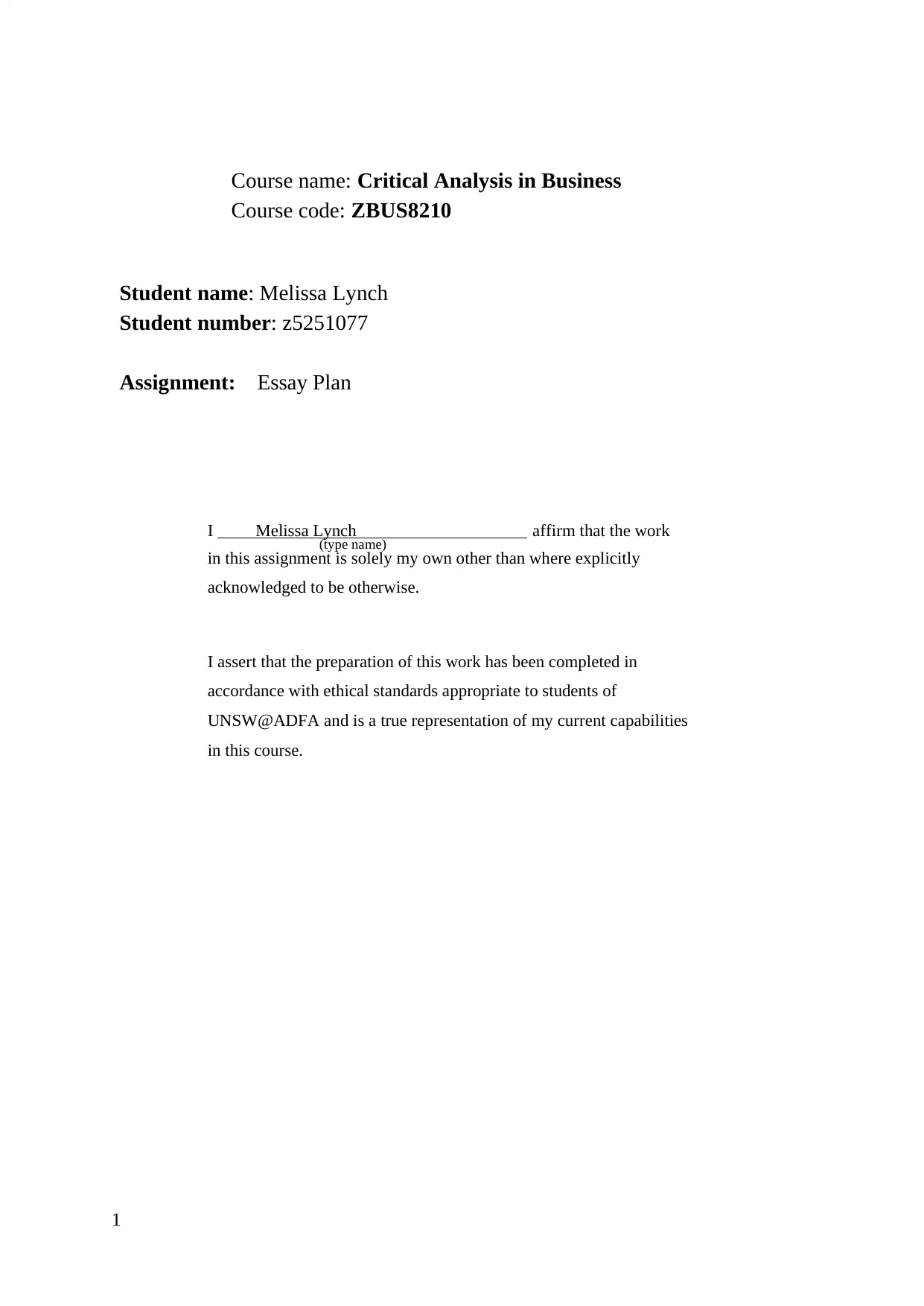
Course name: Critical Analysis in Business
Course code: ZBUS8210
Student name: Melissa Lynch
Student number: z5251077
Assignment: Essay Plan
I Melissa Lynch affirm that the work
(type name)
in this assignment is solely my own other than where explicitly
acknowledged to be otherwise.
I assert that the preparation of this work has been completed in
accordance with ethical standards appropriate to students of
UNSW@ADFA and is a true representation of my current capabilities
in this course.
1
Course code: ZBUS8210
Student name: Melissa Lynch
Student number: z5251077
Assignment: Essay Plan
I Melissa Lynch affirm that the work
(type name)
in this assignment is solely my own other than where explicitly
acknowledged to be otherwise.
I assert that the preparation of this work has been completed in
accordance with ethical standards appropriate to students of
UNSW@ADFA and is a true representation of my current capabilities
in this course.
1
Secure Best Marks with AI Grader
Need help grading? Try our AI Grader for instant feedback on your assignments.
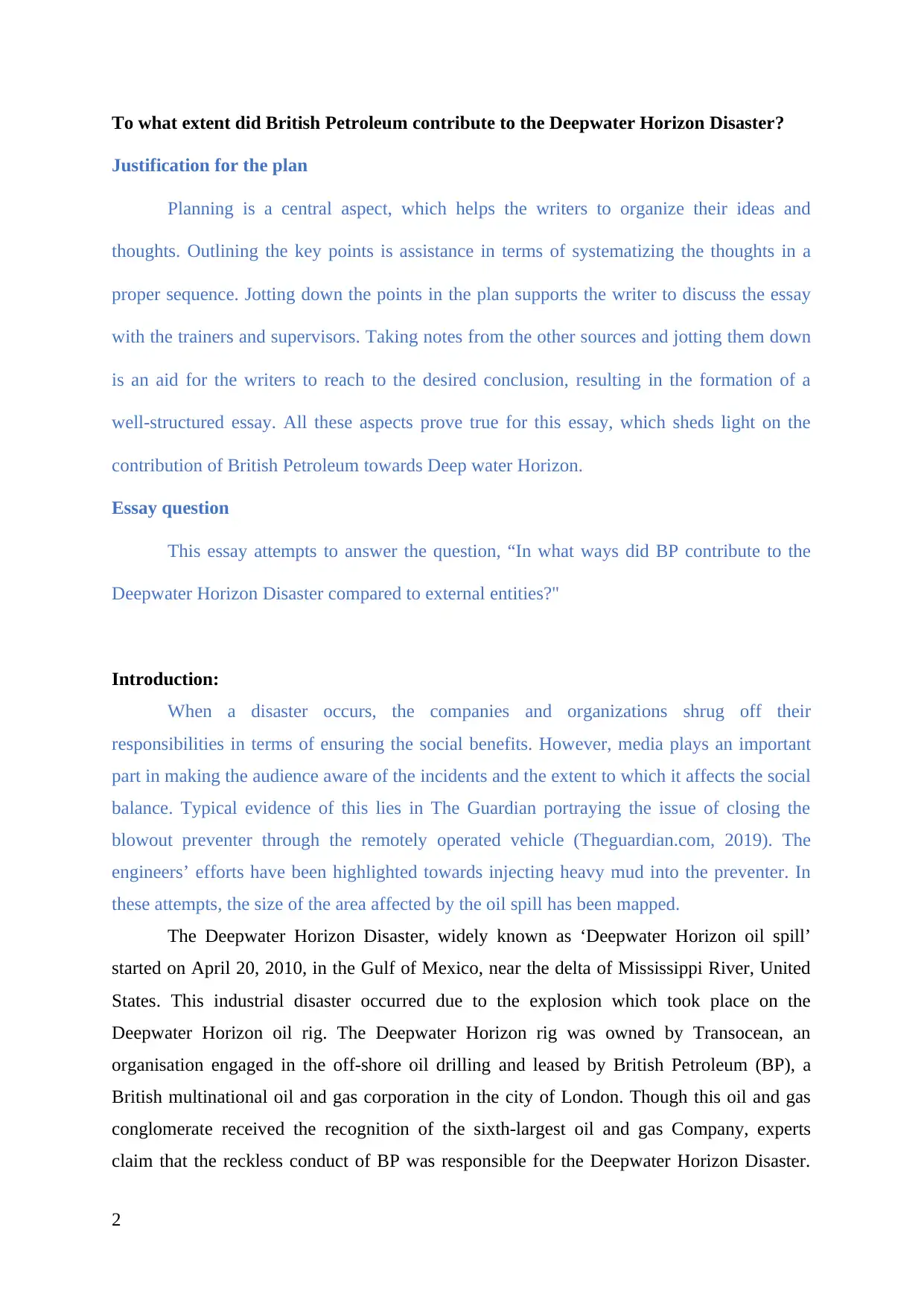
To what extent did British Petroleum contribute to the Deepwater Horizon Disaster?
Justification for the plan
Planning is a central aspect, which helps the writers to organize their ideas and
thoughts. Outlining the key points is assistance in terms of systematizing the thoughts in a
proper sequence. Jotting down the points in the plan supports the writer to discuss the essay
with the trainers and supervisors. Taking notes from the other sources and jotting them down
is an aid for the writers to reach to the desired conclusion, resulting in the formation of a
well-structured essay. All these aspects prove true for this essay, which sheds light on the
contribution of British Petroleum towards Deep water Horizon.
Essay question
This essay attempts to answer the question, “In what ways did BP contribute to the
Deepwater Horizon Disaster compared to external entities?"
Introduction:
When a disaster occurs, the companies and organizations shrug off their
responsibilities in terms of ensuring the social benefits. However, media plays an important
part in making the audience aware of the incidents and the extent to which it affects the social
balance. Typical evidence of this lies in The Guardian portraying the issue of closing the
blowout preventer through the remotely operated vehicle (Theguardian.com, 2019). The
engineers’ efforts have been highlighted towards injecting heavy mud into the preventer. In
these attempts, the size of the area affected by the oil spill has been mapped.
The Deepwater Horizon Disaster, widely known as ‘Deepwater Horizon oil spill’
started on April 20, 2010, in the Gulf of Mexico, near the delta of Mississippi River, United
States. This industrial disaster occurred due to the explosion which took place on the
Deepwater Horizon oil rig. The Deepwater Horizon rig was owned by Transocean, an
organisation engaged in the off-shore oil drilling and leased by British Petroleum (BP), a
British multinational oil and gas corporation in the city of London. Though this oil and gas
conglomerate received the recognition of the sixth-largest oil and gas Company, experts
claim that the reckless conduct of BP was responsible for the Deepwater Horizon Disaster.
2
Justification for the plan
Planning is a central aspect, which helps the writers to organize their ideas and
thoughts. Outlining the key points is assistance in terms of systematizing the thoughts in a
proper sequence. Jotting down the points in the plan supports the writer to discuss the essay
with the trainers and supervisors. Taking notes from the other sources and jotting them down
is an aid for the writers to reach to the desired conclusion, resulting in the formation of a
well-structured essay. All these aspects prove true for this essay, which sheds light on the
contribution of British Petroleum towards Deep water Horizon.
Essay question
This essay attempts to answer the question, “In what ways did BP contribute to the
Deepwater Horizon Disaster compared to external entities?"
Introduction:
When a disaster occurs, the companies and organizations shrug off their
responsibilities in terms of ensuring the social benefits. However, media plays an important
part in making the audience aware of the incidents and the extent to which it affects the social
balance. Typical evidence of this lies in The Guardian portraying the issue of closing the
blowout preventer through the remotely operated vehicle (Theguardian.com, 2019). The
engineers’ efforts have been highlighted towards injecting heavy mud into the preventer. In
these attempts, the size of the area affected by the oil spill has been mapped.
The Deepwater Horizon Disaster, widely known as ‘Deepwater Horizon oil spill’
started on April 20, 2010, in the Gulf of Mexico, near the delta of Mississippi River, United
States. This industrial disaster occurred due to the explosion which took place on the
Deepwater Horizon oil rig. The Deepwater Horizon rig was owned by Transocean, an
organisation engaged in the off-shore oil drilling and leased by British Petroleum (BP), a
British multinational oil and gas corporation in the city of London. Though this oil and gas
conglomerate received the recognition of the sixth-largest oil and gas Company, experts
claim that the reckless conduct of BP was responsible for the Deepwater Horizon Disaster.
2
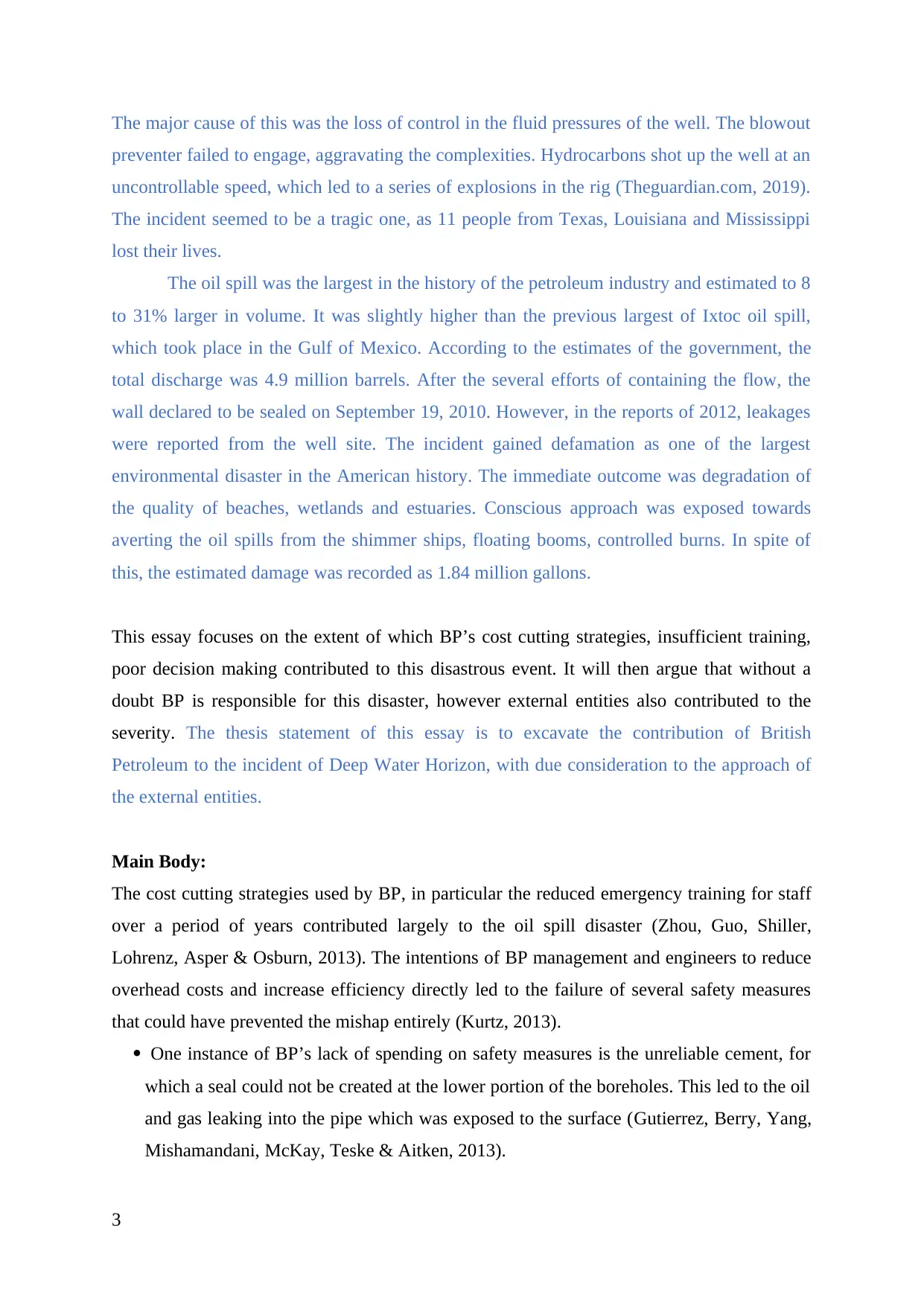
The major cause of this was the loss of control in the fluid pressures of the well. The blowout
preventer failed to engage, aggravating the complexities. Hydrocarbons shot up the well at an
uncontrollable speed, which led to a series of explosions in the rig (Theguardian.com, 2019).
The incident seemed to be a tragic one, as 11 people from Texas, Louisiana and Mississippi
lost their lives.
The oil spill was the largest in the history of the petroleum industry and estimated to 8
to 31% larger in volume. It was slightly higher than the previous largest of Ixtoc oil spill,
which took place in the Gulf of Mexico. According to the estimates of the government, the
total discharge was 4.9 million barrels. After the several efforts of containing the flow, the
wall declared to be sealed on September 19, 2010. However, in the reports of 2012, leakages
were reported from the well site. The incident gained defamation as one of the largest
environmental disaster in the American history. The immediate outcome was degradation of
the quality of beaches, wetlands and estuaries. Conscious approach was exposed towards
averting the oil spills from the shimmer ships, floating booms, controlled burns. In spite of
this, the estimated damage was recorded as 1.84 million gallons.
This essay focuses on the extent of which BP’s cost cutting strategies, insufficient training,
poor decision making contributed to this disastrous event. It will then argue that without a
doubt BP is responsible for this disaster, however external entities also contributed to the
severity. The thesis statement of this essay is to excavate the contribution of British
Petroleum to the incident of Deep Water Horizon, with due consideration to the approach of
the external entities.
Main Body:
The cost cutting strategies used by BP, in particular the reduced emergency training for staff
over a period of years contributed largely to the oil spill disaster (Zhou, Guo, Shiller,
Lohrenz, Asper & Osburn, 2013). The intentions of BP management and engineers to reduce
overhead costs and increase efficiency directly led to the failure of several safety measures
that could have prevented the mishap entirely (Kurtz, 2013).
One instance of BP’s lack of spending on safety measures is the unreliable cement, for
which a seal could not be created at the lower portion of the boreholes. This led to the oil
and gas leaking into the pipe which was exposed to the surface (Gutierrez, Berry, Yang,
Mishamandani, McKay, Teske & Aitken, 2013).
3
preventer failed to engage, aggravating the complexities. Hydrocarbons shot up the well at an
uncontrollable speed, which led to a series of explosions in the rig (Theguardian.com, 2019).
The incident seemed to be a tragic one, as 11 people from Texas, Louisiana and Mississippi
lost their lives.
The oil spill was the largest in the history of the petroleum industry and estimated to 8
to 31% larger in volume. It was slightly higher than the previous largest of Ixtoc oil spill,
which took place in the Gulf of Mexico. According to the estimates of the government, the
total discharge was 4.9 million barrels. After the several efforts of containing the flow, the
wall declared to be sealed on September 19, 2010. However, in the reports of 2012, leakages
were reported from the well site. The incident gained defamation as one of the largest
environmental disaster in the American history. The immediate outcome was degradation of
the quality of beaches, wetlands and estuaries. Conscious approach was exposed towards
averting the oil spills from the shimmer ships, floating booms, controlled burns. In spite of
this, the estimated damage was recorded as 1.84 million gallons.
This essay focuses on the extent of which BP’s cost cutting strategies, insufficient training,
poor decision making contributed to this disastrous event. It will then argue that without a
doubt BP is responsible for this disaster, however external entities also contributed to the
severity. The thesis statement of this essay is to excavate the contribution of British
Petroleum to the incident of Deep Water Horizon, with due consideration to the approach of
the external entities.
Main Body:
The cost cutting strategies used by BP, in particular the reduced emergency training for staff
over a period of years contributed largely to the oil spill disaster (Zhou, Guo, Shiller,
Lohrenz, Asper & Osburn, 2013). The intentions of BP management and engineers to reduce
overhead costs and increase efficiency directly led to the failure of several safety measures
that could have prevented the mishap entirely (Kurtz, 2013).
One instance of BP’s lack of spending on safety measures is the unreliable cement, for
which a seal could not be created at the lower portion of the boreholes. This led to the oil
and gas leaking into the pipe which was exposed to the surface (Gutierrez, Berry, Yang,
Mishamandani, McKay, Teske & Aitken, 2013).
3
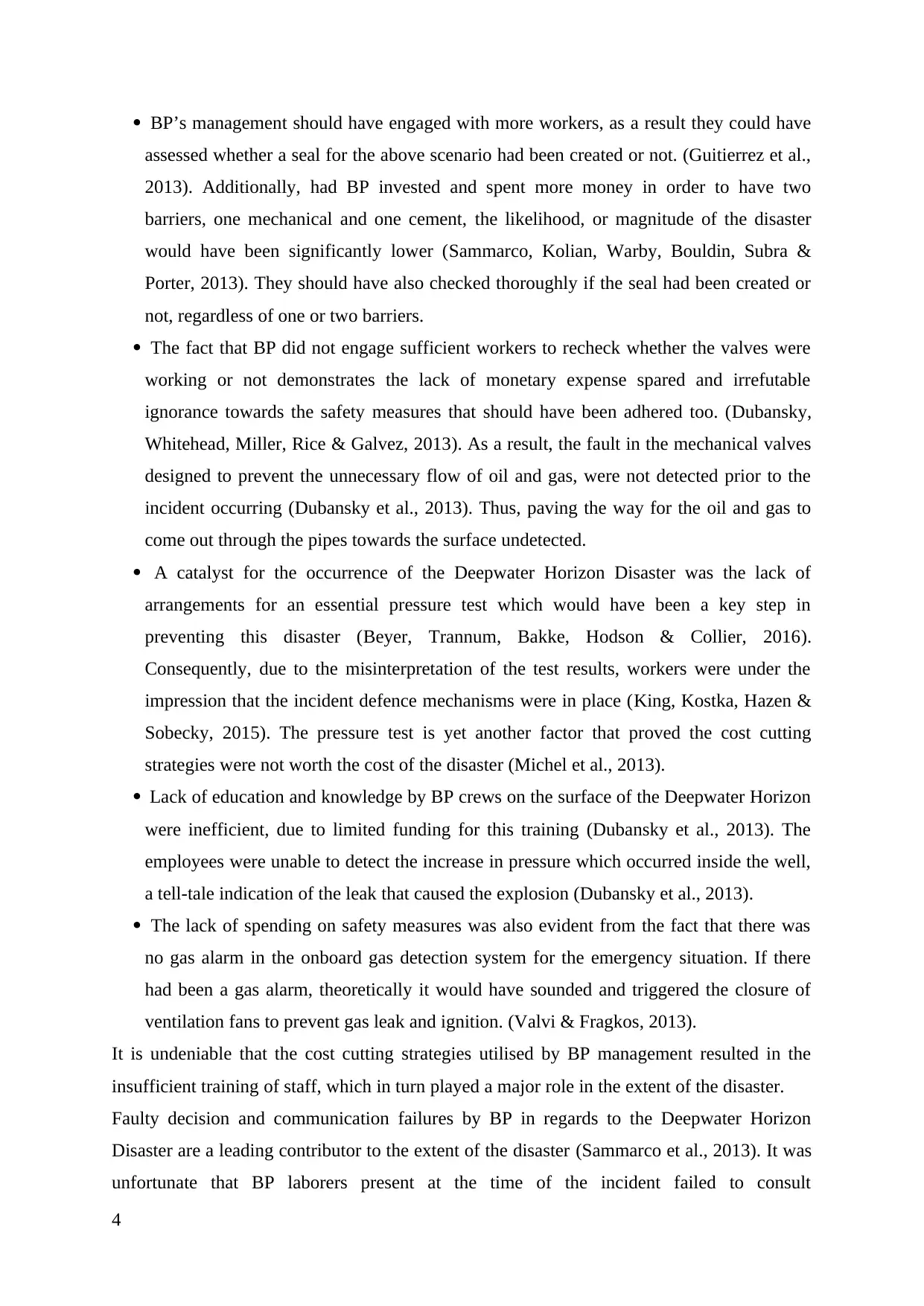
BP’s management should have engaged with more workers, as a result they could have
assessed whether a seal for the above scenario had been created or not. (Guitierrez et al.,
2013). Additionally, had BP invested and spent more money in order to have two
barriers, one mechanical and one cement, the likelihood, or magnitude of the disaster
would have been significantly lower (Sammarco, Kolian, Warby, Bouldin, Subra &
Porter, 2013). They should have also checked thoroughly if the seal had been created or
not, regardless of one or two barriers.
The fact that BP did not engage sufficient workers to recheck whether the valves were
working or not demonstrates the lack of monetary expense spared and irrefutable
ignorance towards the safety measures that should have been adhered too. (Dubansky,
Whitehead, Miller, Rice & Galvez, 2013). As a result, the fault in the mechanical valves
designed to prevent the unnecessary flow of oil and gas, were not detected prior to the
incident occurring (Dubansky et al., 2013). Thus, paving the way for the oil and gas to
come out through the pipes towards the surface undetected.
A catalyst for the occurrence of the Deepwater Horizon Disaster was the lack of
arrangements for an essential pressure test which would have been a key step in
preventing this disaster (Beyer, Trannum, Bakke, Hodson & Collier, 2016).
Consequently, due to the misinterpretation of the test results, workers were under the
impression that the incident defence mechanisms were in place (King, Kostka, Hazen &
Sobecky, 2015). The pressure test is yet another factor that proved the cost cutting
strategies were not worth the cost of the disaster (Michel et al., 2013).
Lack of education and knowledge by BP crews on the surface of the Deepwater Horizon
were inefficient, due to limited funding for this training (Dubansky et al., 2013). The
employees were unable to detect the increase in pressure which occurred inside the well,
a tell-tale indication of the leak that caused the explosion (Dubansky et al., 2013).
The lack of spending on safety measures was also evident from the fact that there was
no gas alarm in the onboard gas detection system for the emergency situation. If there
had been a gas alarm, theoretically it would have sounded and triggered the closure of
ventilation fans to prevent gas leak and ignition. (Valvi & Fragkos, 2013).
It is undeniable that the cost cutting strategies utilised by BP management resulted in the
insufficient training of staff, which in turn played a major role in the extent of the disaster.
Faulty decision and communication failures by BP in regards to the Deepwater Horizon
Disaster are a leading contributor to the extent of the disaster (Sammarco et al., 2013). It was
unfortunate that BP laborers present at the time of the incident failed to consult
4
assessed whether a seal for the above scenario had been created or not. (Guitierrez et al.,
2013). Additionally, had BP invested and spent more money in order to have two
barriers, one mechanical and one cement, the likelihood, or magnitude of the disaster
would have been significantly lower (Sammarco, Kolian, Warby, Bouldin, Subra &
Porter, 2013). They should have also checked thoroughly if the seal had been created or
not, regardless of one or two barriers.
The fact that BP did not engage sufficient workers to recheck whether the valves were
working or not demonstrates the lack of monetary expense spared and irrefutable
ignorance towards the safety measures that should have been adhered too. (Dubansky,
Whitehead, Miller, Rice & Galvez, 2013). As a result, the fault in the mechanical valves
designed to prevent the unnecessary flow of oil and gas, were not detected prior to the
incident occurring (Dubansky et al., 2013). Thus, paving the way for the oil and gas to
come out through the pipes towards the surface undetected.
A catalyst for the occurrence of the Deepwater Horizon Disaster was the lack of
arrangements for an essential pressure test which would have been a key step in
preventing this disaster (Beyer, Trannum, Bakke, Hodson & Collier, 2016).
Consequently, due to the misinterpretation of the test results, workers were under the
impression that the incident defence mechanisms were in place (King, Kostka, Hazen &
Sobecky, 2015). The pressure test is yet another factor that proved the cost cutting
strategies were not worth the cost of the disaster (Michel et al., 2013).
Lack of education and knowledge by BP crews on the surface of the Deepwater Horizon
were inefficient, due to limited funding for this training (Dubansky et al., 2013). The
employees were unable to detect the increase in pressure which occurred inside the well,
a tell-tale indication of the leak that caused the explosion (Dubansky et al., 2013).
The lack of spending on safety measures was also evident from the fact that there was
no gas alarm in the onboard gas detection system for the emergency situation. If there
had been a gas alarm, theoretically it would have sounded and triggered the closure of
ventilation fans to prevent gas leak and ignition. (Valvi & Fragkos, 2013).
It is undeniable that the cost cutting strategies utilised by BP management resulted in the
insufficient training of staff, which in turn played a major role in the extent of the disaster.
Faulty decision and communication failures by BP in regards to the Deepwater Horizon
Disaster are a leading contributor to the extent of the disaster (Sammarco et al., 2013). It was
unfortunate that BP laborers present at the time of the incident failed to consult
4
Secure Best Marks with AI Grader
Need help grading? Try our AI Grader for instant feedback on your assignments.
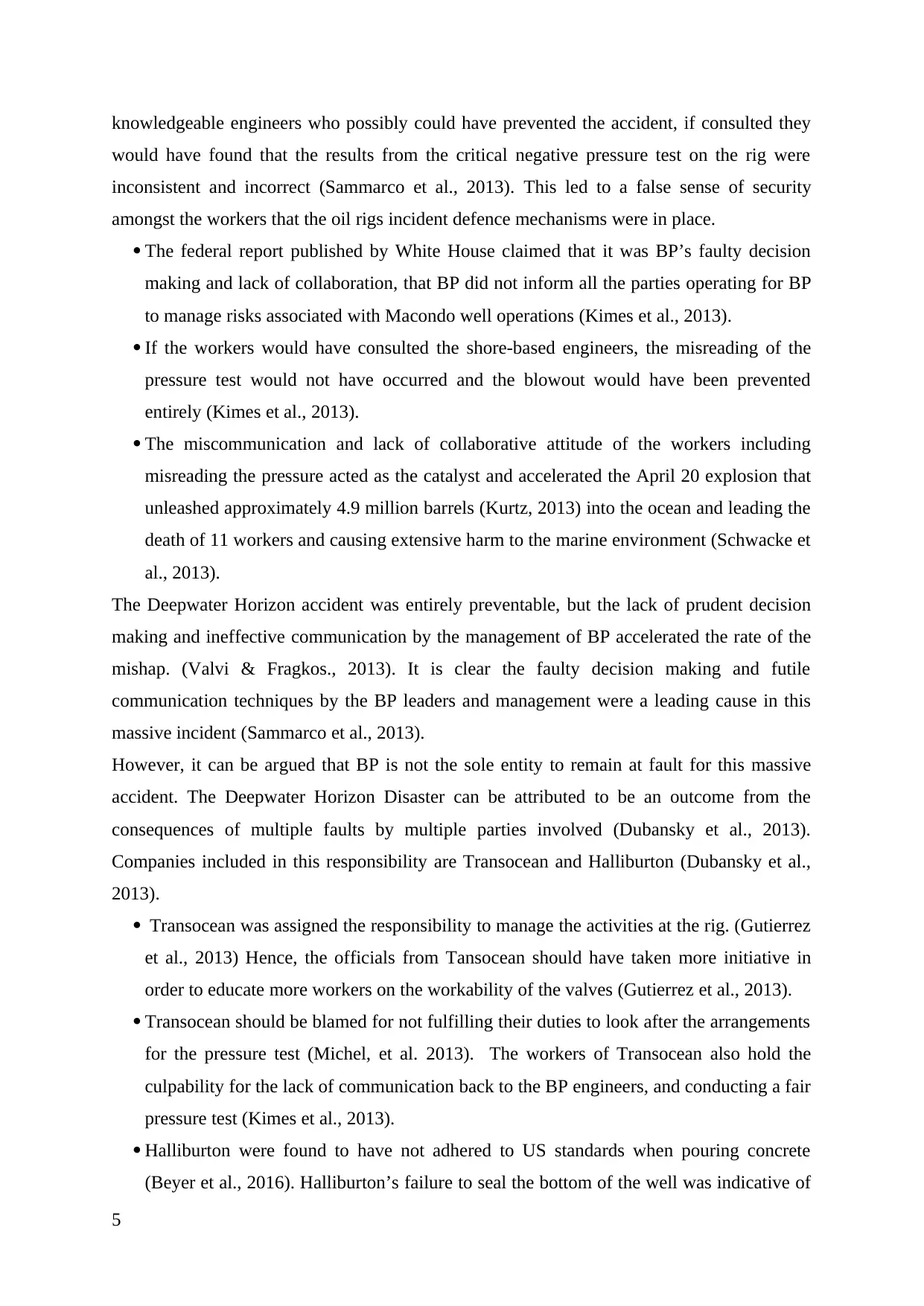
knowledgeable engineers who possibly could have prevented the accident, if consulted they
would have found that the results from the critical negative pressure test on the rig were
inconsistent and incorrect (Sammarco et al., 2013). This led to a false sense of security
amongst the workers that the oil rigs incident defence mechanisms were in place.
The federal report published by White House claimed that it was BP’s faulty decision
making and lack of collaboration, that BP did not inform all the parties operating for BP
to manage risks associated with Macondo well operations (Kimes et al., 2013).
If the workers would have consulted the shore-based engineers, the misreading of the
pressure test would not have occurred and the blowout would have been prevented
entirely (Kimes et al., 2013).
The miscommunication and lack of collaborative attitude of the workers including
misreading the pressure acted as the catalyst and accelerated the April 20 explosion that
unleashed approximately 4.9 million barrels (Kurtz, 2013) into the ocean and leading the
death of 11 workers and causing extensive harm to the marine environment (Schwacke et
al., 2013).
The Deepwater Horizon accident was entirely preventable, but the lack of prudent decision
making and ineffective communication by the management of BP accelerated the rate of the
mishap. (Valvi & Fragkos., 2013). It is clear the faulty decision making and futile
communication techniques by the BP leaders and management were a leading cause in this
massive incident (Sammarco et al., 2013).
However, it can be argued that BP is not the sole entity to remain at fault for this massive
accident. The Deepwater Horizon Disaster can be attributed to be an outcome from the
consequences of multiple faults by multiple parties involved (Dubansky et al., 2013).
Companies included in this responsibility are Transocean and Halliburton (Dubansky et al.,
2013).
Transocean was assigned the responsibility to manage the activities at the rig. (Gutierrez
et al., 2013) Hence, the officials from Tansocean should have taken more initiative in
order to educate more workers on the workability of the valves (Gutierrez et al., 2013).
Transocean should be blamed for not fulfilling their duties to look after the arrangements
for the pressure test (Michel, et al. 2013). The workers of Transocean also hold the
culpability for the lack of communication back to the BP engineers, and conducting a fair
pressure test (Kimes et al., 2013).
Halliburton were found to have not adhered to US standards when pouring concrete
(Beyer et al., 2016). Halliburton’s failure to seal the bottom of the well was indicative of
5
would have found that the results from the critical negative pressure test on the rig were
inconsistent and incorrect (Sammarco et al., 2013). This led to a false sense of security
amongst the workers that the oil rigs incident defence mechanisms were in place.
The federal report published by White House claimed that it was BP’s faulty decision
making and lack of collaboration, that BP did not inform all the parties operating for BP
to manage risks associated with Macondo well operations (Kimes et al., 2013).
If the workers would have consulted the shore-based engineers, the misreading of the
pressure test would not have occurred and the blowout would have been prevented
entirely (Kimes et al., 2013).
The miscommunication and lack of collaborative attitude of the workers including
misreading the pressure acted as the catalyst and accelerated the April 20 explosion that
unleashed approximately 4.9 million barrels (Kurtz, 2013) into the ocean and leading the
death of 11 workers and causing extensive harm to the marine environment (Schwacke et
al., 2013).
The Deepwater Horizon accident was entirely preventable, but the lack of prudent decision
making and ineffective communication by the management of BP accelerated the rate of the
mishap. (Valvi & Fragkos., 2013). It is clear the faulty decision making and futile
communication techniques by the BP leaders and management were a leading cause in this
massive incident (Sammarco et al., 2013).
However, it can be argued that BP is not the sole entity to remain at fault for this massive
accident. The Deepwater Horizon Disaster can be attributed to be an outcome from the
consequences of multiple faults by multiple parties involved (Dubansky et al., 2013).
Companies included in this responsibility are Transocean and Halliburton (Dubansky et al.,
2013).
Transocean was assigned the responsibility to manage the activities at the rig. (Gutierrez
et al., 2013) Hence, the officials from Tansocean should have taken more initiative in
order to educate more workers on the workability of the valves (Gutierrez et al., 2013).
Transocean should be blamed for not fulfilling their duties to look after the arrangements
for the pressure test (Michel, et al. 2013). The workers of Transocean also hold the
culpability for the lack of communication back to the BP engineers, and conducting a fair
pressure test (Kimes et al., 2013).
Halliburton were found to have not adhered to US standards when pouring concrete
(Beyer et al., 2016). Halliburton’s failure to seal the bottom of the well was indicative of
5
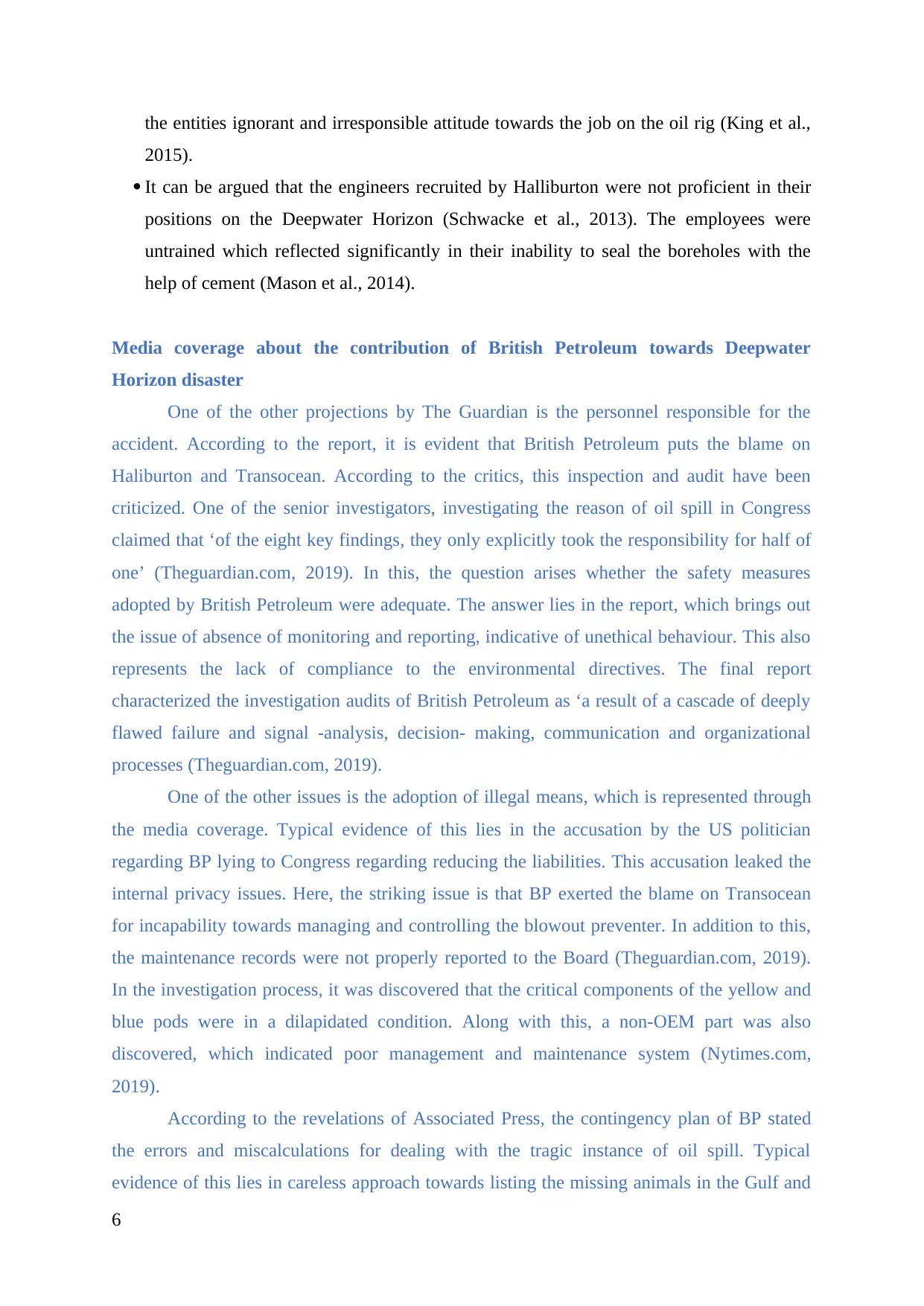
the entities ignorant and irresponsible attitude towards the job on the oil rig (King et al.,
2015).
It can be argued that the engineers recruited by Halliburton were not proficient in their
positions on the Deepwater Horizon (Schwacke et al., 2013). The employees were
untrained which reflected significantly in their inability to seal the boreholes with the
help of cement (Mason et al., 2014).
Media coverage about the contribution of British Petroleum towards Deepwater
Horizon disaster
One of the other projections by The Guardian is the personnel responsible for the
accident. According to the report, it is evident that British Petroleum puts the blame on
Haliburton and Transocean. According to the critics, this inspection and audit have been
criticized. One of the senior investigators, investigating the reason of oil spill in Congress
claimed that ‘of the eight key findings, they only explicitly took the responsibility for half of
one’ (Theguardian.com, 2019). In this, the question arises whether the safety measures
adopted by British Petroleum were adequate. The answer lies in the report, which brings out
the issue of absence of monitoring and reporting, indicative of unethical behaviour. This also
represents the lack of compliance to the environmental directives. The final report
characterized the investigation audits of British Petroleum as ‘a result of a cascade of deeply
flawed failure and signal -analysis, decision- making, communication and organizational
processes (Theguardian.com, 2019).
One of the other issues is the adoption of illegal means, which is represented through
the media coverage. Typical evidence of this lies in the accusation by the US politician
regarding BP lying to Congress regarding reducing the liabilities. This accusation leaked the
internal privacy issues. Here, the striking issue is that BP exerted the blame on Transocean
for incapability towards managing and controlling the blowout preventer. In addition to this,
the maintenance records were not properly reported to the Board (Theguardian.com, 2019).
In the investigation process, it was discovered that the critical components of the yellow and
blue pods were in a dilapidated condition. Along with this, a non-OEM part was also
discovered, which indicated poor management and maintenance system (Nytimes.com,
2019).
According to the revelations of Associated Press, the contingency plan of BP stated
the errors and miscalculations for dealing with the tragic instance of oil spill. Typical
evidence of this lies in careless approach towards listing the missing animals in the Gulf and
6
2015).
It can be argued that the engineers recruited by Halliburton were not proficient in their
positions on the Deepwater Horizon (Schwacke et al., 2013). The employees were
untrained which reflected significantly in their inability to seal the boreholes with the
help of cement (Mason et al., 2014).
Media coverage about the contribution of British Petroleum towards Deepwater
Horizon disaster
One of the other projections by The Guardian is the personnel responsible for the
accident. According to the report, it is evident that British Petroleum puts the blame on
Haliburton and Transocean. According to the critics, this inspection and audit have been
criticized. One of the senior investigators, investigating the reason of oil spill in Congress
claimed that ‘of the eight key findings, they only explicitly took the responsibility for half of
one’ (Theguardian.com, 2019). In this, the question arises whether the safety measures
adopted by British Petroleum were adequate. The answer lies in the report, which brings out
the issue of absence of monitoring and reporting, indicative of unethical behaviour. This also
represents the lack of compliance to the environmental directives. The final report
characterized the investigation audits of British Petroleum as ‘a result of a cascade of deeply
flawed failure and signal -analysis, decision- making, communication and organizational
processes (Theguardian.com, 2019).
One of the other issues is the adoption of illegal means, which is represented through
the media coverage. Typical evidence of this lies in the accusation by the US politician
regarding BP lying to Congress regarding reducing the liabilities. This accusation leaked the
internal privacy issues. Here, the striking issue is that BP exerted the blame on Transocean
for incapability towards managing and controlling the blowout preventer. In addition to this,
the maintenance records were not properly reported to the Board (Theguardian.com, 2019).
In the investigation process, it was discovered that the critical components of the yellow and
blue pods were in a dilapidated condition. Along with this, a non-OEM part was also
discovered, which indicated poor management and maintenance system (Nytimes.com,
2019).
According to the revelations of Associated Press, the contingency plan of BP stated
the errors and miscalculations for dealing with the tragic instance of oil spill. Typical
evidence of this lies in careless approach towards listing the missing animals in the Gulf and
6
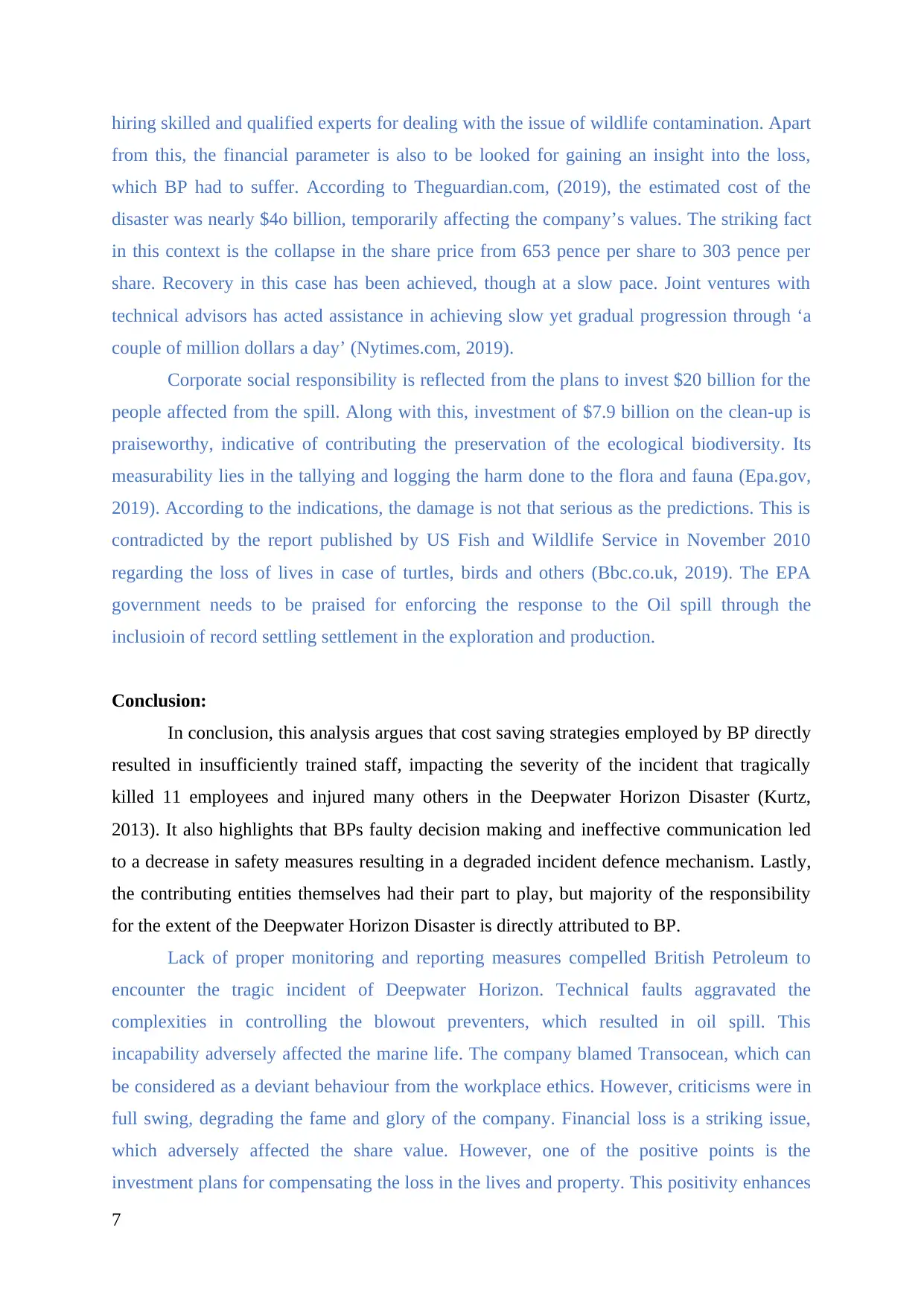
hiring skilled and qualified experts for dealing with the issue of wildlife contamination. Apart
from this, the financial parameter is also to be looked for gaining an insight into the loss,
which BP had to suffer. According to Theguardian.com, (2019), the estimated cost of the
disaster was nearly $4o billion, temporarily affecting the company’s values. The striking fact
in this context is the collapse in the share price from 653 pence per share to 303 pence per
share. Recovery in this case has been achieved, though at a slow pace. Joint ventures with
technical advisors has acted assistance in achieving slow yet gradual progression through ‘a
couple of million dollars a day’ (Nytimes.com, 2019).
Corporate social responsibility is reflected from the plans to invest $20 billion for the
people affected from the spill. Along with this, investment of $7.9 billion on the clean-up is
praiseworthy, indicative of contributing the preservation of the ecological biodiversity. Its
measurability lies in the tallying and logging the harm done to the flora and fauna (Epa.gov,
2019). According to the indications, the damage is not that serious as the predictions. This is
contradicted by the report published by US Fish and Wildlife Service in November 2010
regarding the loss of lives in case of turtles, birds and others (Bbc.co.uk, 2019). The EPA
government needs to be praised for enforcing the response to the Oil spill through the
inclusioin of record settling settlement in the exploration and production.
Conclusion:
In conclusion, this analysis argues that cost saving strategies employed by BP directly
resulted in insufficiently trained staff, impacting the severity of the incident that tragically
killed 11 employees and injured many others in the Deepwater Horizon Disaster (Kurtz,
2013). It also highlights that BPs faulty decision making and ineffective communication led
to a decrease in safety measures resulting in a degraded incident defence mechanism. Lastly,
the contributing entities themselves had their part to play, but majority of the responsibility
for the extent of the Deepwater Horizon Disaster is directly attributed to BP.
Lack of proper monitoring and reporting measures compelled British Petroleum to
encounter the tragic incident of Deepwater Horizon. Technical faults aggravated the
complexities in controlling the blowout preventers, which resulted in oil spill. This
incapability adversely affected the marine life. The company blamed Transocean, which can
be considered as a deviant behaviour from the workplace ethics. However, criticisms were in
full swing, degrading the fame and glory of the company. Financial loss is a striking issue,
which adversely affected the share value. However, one of the positive points is the
investment plans for compensating the loss in the lives and property. This positivity enhances
7
from this, the financial parameter is also to be looked for gaining an insight into the loss,
which BP had to suffer. According to Theguardian.com, (2019), the estimated cost of the
disaster was nearly $4o billion, temporarily affecting the company’s values. The striking fact
in this context is the collapse in the share price from 653 pence per share to 303 pence per
share. Recovery in this case has been achieved, though at a slow pace. Joint ventures with
technical advisors has acted assistance in achieving slow yet gradual progression through ‘a
couple of million dollars a day’ (Nytimes.com, 2019).
Corporate social responsibility is reflected from the plans to invest $20 billion for the
people affected from the spill. Along with this, investment of $7.9 billion on the clean-up is
praiseworthy, indicative of contributing the preservation of the ecological biodiversity. Its
measurability lies in the tallying and logging the harm done to the flora and fauna (Epa.gov,
2019). According to the indications, the damage is not that serious as the predictions. This is
contradicted by the report published by US Fish and Wildlife Service in November 2010
regarding the loss of lives in case of turtles, birds and others (Bbc.co.uk, 2019). The EPA
government needs to be praised for enforcing the response to the Oil spill through the
inclusioin of record settling settlement in the exploration and production.
Conclusion:
In conclusion, this analysis argues that cost saving strategies employed by BP directly
resulted in insufficiently trained staff, impacting the severity of the incident that tragically
killed 11 employees and injured many others in the Deepwater Horizon Disaster (Kurtz,
2013). It also highlights that BPs faulty decision making and ineffective communication led
to a decrease in safety measures resulting in a degraded incident defence mechanism. Lastly,
the contributing entities themselves had their part to play, but majority of the responsibility
for the extent of the Deepwater Horizon Disaster is directly attributed to BP.
Lack of proper monitoring and reporting measures compelled British Petroleum to
encounter the tragic incident of Deepwater Horizon. Technical faults aggravated the
complexities in controlling the blowout preventers, which resulted in oil spill. This
incapability adversely affected the marine life. The company blamed Transocean, which can
be considered as a deviant behaviour from the workplace ethics. However, criticisms were in
full swing, degrading the fame and glory of the company. Financial loss is a striking issue,
which adversely affected the share value. However, one of the positive points is the
investment plans for compensating the loss in the lives and property. This positivity enhances
7
Paraphrase This Document
Need a fresh take? Get an instant paraphrase of this document with our AI Paraphraser

the parameter of corporate social responsibility of the company, indicating a conscious
approach towards restoring the balance in the ecosystem.
8
approach towards restoring the balance in the ecosystem.
8
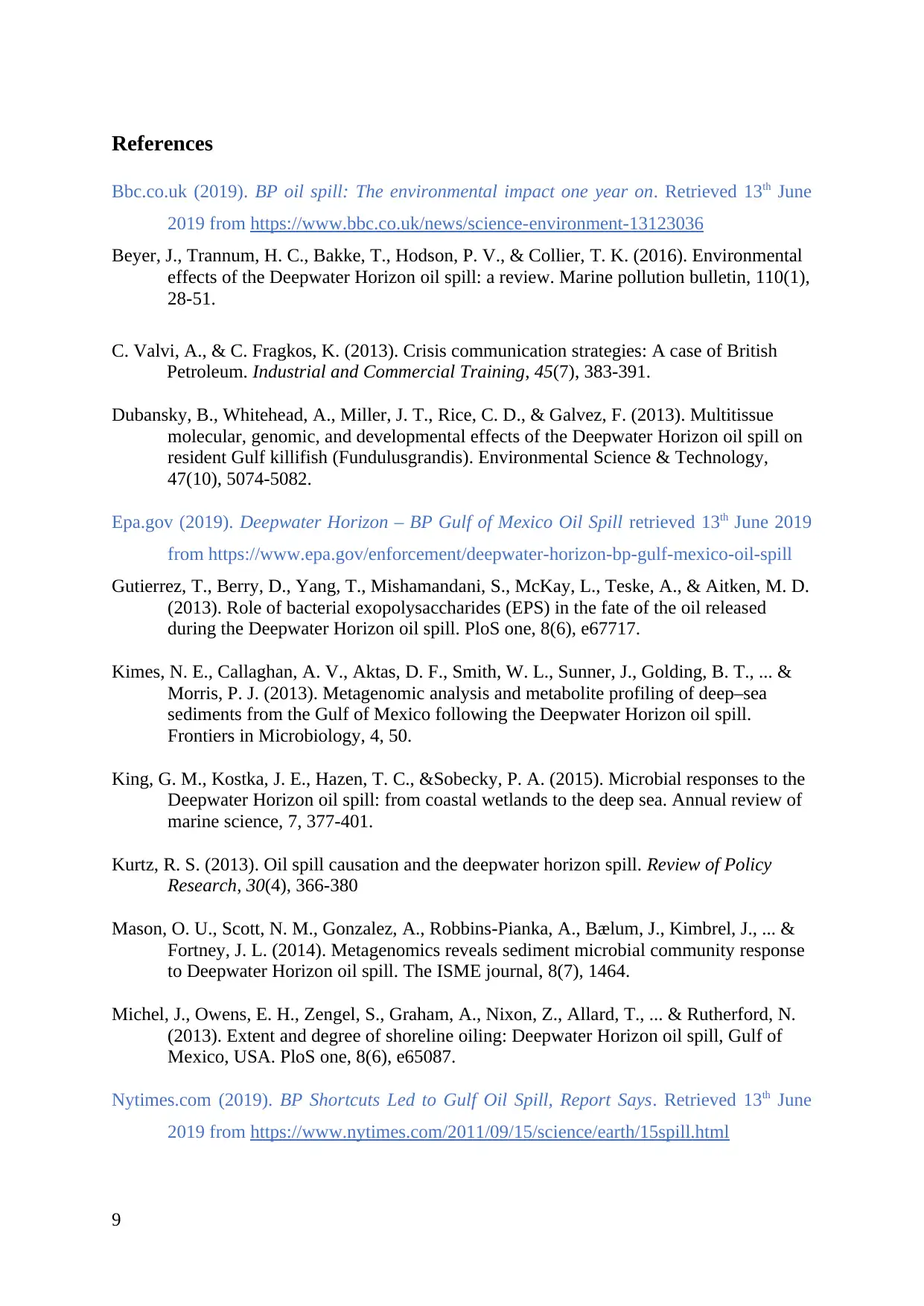
References
Bbc.co.uk (2019). BP oil spill: The environmental impact one year on. Retrieved 13th June
2019 from https://www.bbc.co.uk/news/science-environment-13123036
Beyer, J., Trannum, H. C., Bakke, T., Hodson, P. V., & Collier, T. K. (2016). Environmental
effects of the Deepwater Horizon oil spill: a review. Marine pollution bulletin, 110(1),
28-51.
C. Valvi, A., & C. Fragkos, K. (2013). Crisis communication strategies: A case of British
Petroleum. Industrial and Commercial Training, 45(7), 383-391.
Dubansky, B., Whitehead, A., Miller, J. T., Rice, C. D., & Galvez, F. (2013). Multitissue
molecular, genomic, and developmental effects of the Deepwater Horizon oil spill on
resident Gulf killifish (Fundulusgrandis). Environmental Science & Technology,
47(10), 5074-5082.
Epa.gov (2019). Deepwater Horizon – BP Gulf of Mexico Oil Spill retrieved 13th June 2019
from https://www.epa.gov/enforcement/deepwater-horizon-bp-gulf-mexico-oil-spill
Gutierrez, T., Berry, D., Yang, T., Mishamandani, S., McKay, L., Teske, A., & Aitken, M. D.
(2013). Role of bacterial exopolysaccharides (EPS) in the fate of the oil released
during the Deepwater Horizon oil spill. PloS one, 8(6), e67717.
Kimes, N. E., Callaghan, A. V., Aktas, D. F., Smith, W. L., Sunner, J., Golding, B. T., ... &
Morris, P. J. (2013). Metagenomic analysis and metabolite profiling of deep–sea
sediments from the Gulf of Mexico following the Deepwater Horizon oil spill.
Frontiers in Microbiology, 4, 50.
King, G. M., Kostka, J. E., Hazen, T. C., &Sobecky, P. A. (2015). Microbial responses to the
Deepwater Horizon oil spill: from coastal wetlands to the deep sea. Annual review of
marine science, 7, 377-401.
Kurtz, R. S. (2013). Oil spill causation and the deepwater horizon spill. Review of Policy
Research, 30(4), 366-380
Mason, O. U., Scott, N. M., Gonzalez, A., Robbins-Pianka, A., Bælum, J., Kimbrel, J., ... &
Fortney, J. L. (2014). Metagenomics reveals sediment microbial community response
to Deepwater Horizon oil spill. The ISME journal, 8(7), 1464.
Michel, J., Owens, E. H., Zengel, S., Graham, A., Nixon, Z., Allard, T., ... & Rutherford, N.
(2013). Extent and degree of shoreline oiling: Deepwater Horizon oil spill, Gulf of
Mexico, USA. PloS one, 8(6), e65087.
Nytimes.com (2019). BP Shortcuts Led to Gulf Oil Spill, Report Says. Retrieved 13th June
2019 from https://www.nytimes.com/2011/09/15/science/earth/15spill.html
9
Bbc.co.uk (2019). BP oil spill: The environmental impact one year on. Retrieved 13th June
2019 from https://www.bbc.co.uk/news/science-environment-13123036
Beyer, J., Trannum, H. C., Bakke, T., Hodson, P. V., & Collier, T. K. (2016). Environmental
effects of the Deepwater Horizon oil spill: a review. Marine pollution bulletin, 110(1),
28-51.
C. Valvi, A., & C. Fragkos, K. (2013). Crisis communication strategies: A case of British
Petroleum. Industrial and Commercial Training, 45(7), 383-391.
Dubansky, B., Whitehead, A., Miller, J. T., Rice, C. D., & Galvez, F. (2013). Multitissue
molecular, genomic, and developmental effects of the Deepwater Horizon oil spill on
resident Gulf killifish (Fundulusgrandis). Environmental Science & Technology,
47(10), 5074-5082.
Epa.gov (2019). Deepwater Horizon – BP Gulf of Mexico Oil Spill retrieved 13th June 2019
from https://www.epa.gov/enforcement/deepwater-horizon-bp-gulf-mexico-oil-spill
Gutierrez, T., Berry, D., Yang, T., Mishamandani, S., McKay, L., Teske, A., & Aitken, M. D.
(2013). Role of bacterial exopolysaccharides (EPS) in the fate of the oil released
during the Deepwater Horizon oil spill. PloS one, 8(6), e67717.
Kimes, N. E., Callaghan, A. V., Aktas, D. F., Smith, W. L., Sunner, J., Golding, B. T., ... &
Morris, P. J. (2013). Metagenomic analysis and metabolite profiling of deep–sea
sediments from the Gulf of Mexico following the Deepwater Horizon oil spill.
Frontiers in Microbiology, 4, 50.
King, G. M., Kostka, J. E., Hazen, T. C., &Sobecky, P. A. (2015). Microbial responses to the
Deepwater Horizon oil spill: from coastal wetlands to the deep sea. Annual review of
marine science, 7, 377-401.
Kurtz, R. S. (2013). Oil spill causation and the deepwater horizon spill. Review of Policy
Research, 30(4), 366-380
Mason, O. U., Scott, N. M., Gonzalez, A., Robbins-Pianka, A., Bælum, J., Kimbrel, J., ... &
Fortney, J. L. (2014). Metagenomics reveals sediment microbial community response
to Deepwater Horizon oil spill. The ISME journal, 8(7), 1464.
Michel, J., Owens, E. H., Zengel, S., Graham, A., Nixon, Z., Allard, T., ... & Rutherford, N.
(2013). Extent and degree of shoreline oiling: Deepwater Horizon oil spill, Gulf of
Mexico, USA. PloS one, 8(6), e65087.
Nytimes.com (2019). BP Shortcuts Led to Gulf Oil Spill, Report Says. Retrieved 13th June
2019 from https://www.nytimes.com/2011/09/15/science/earth/15spill.html
9
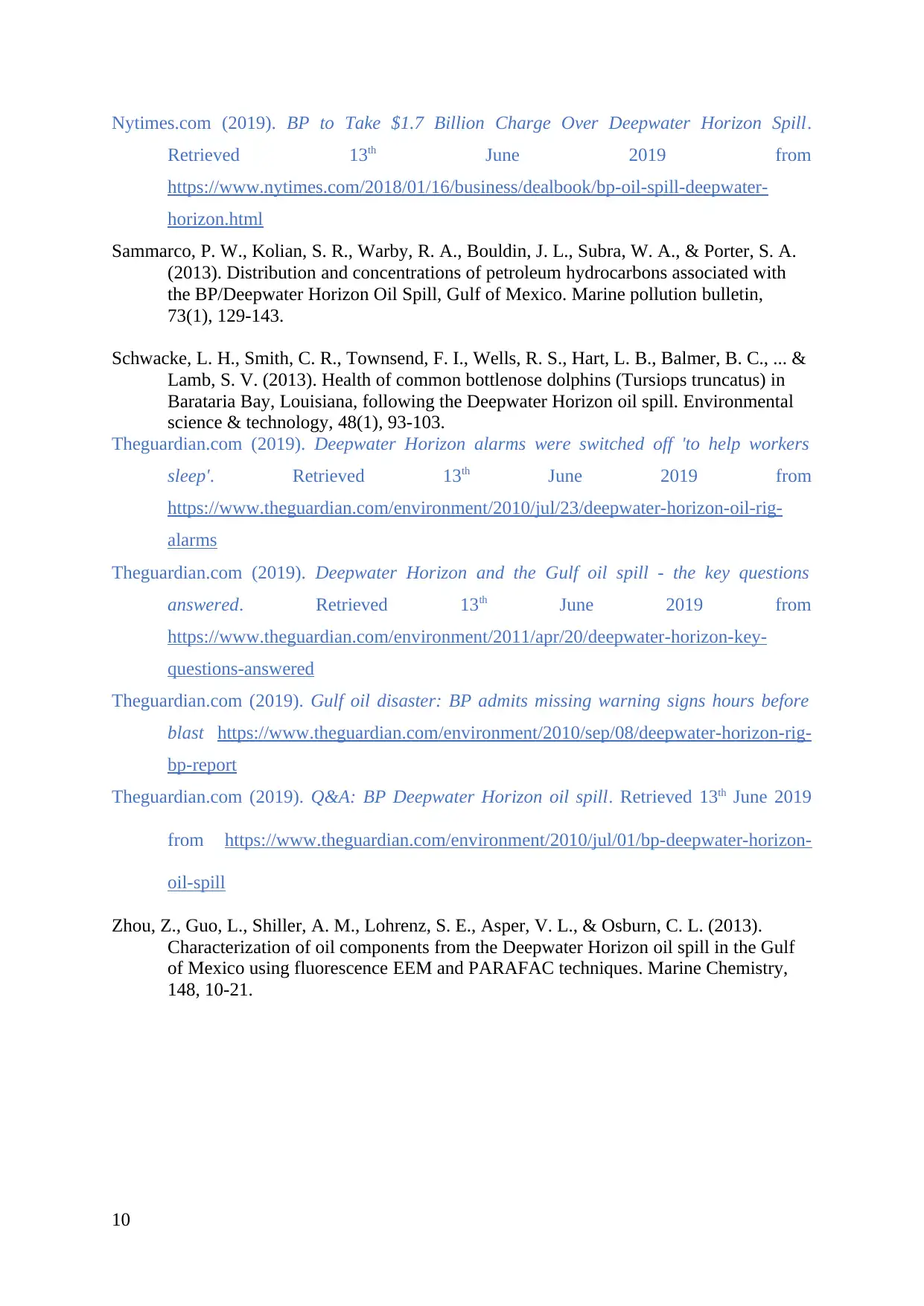
Nytimes.com (2019). BP to Take $1.7 Billion Charge Over Deepwater Horizon Spill.
Retrieved 13th June 2019 from
https://www.nytimes.com/2018/01/16/business/dealbook/bp-oil-spill-deepwater-
horizon.html
Sammarco, P. W., Kolian, S. R., Warby, R. A., Bouldin, J. L., Subra, W. A., & Porter, S. A.
(2013). Distribution and concentrations of petroleum hydrocarbons associated with
the BP/Deepwater Horizon Oil Spill, Gulf of Mexico. Marine pollution bulletin,
73(1), 129-143.
Schwacke, L. H., Smith, C. R., Townsend, F. I., Wells, R. S., Hart, L. B., Balmer, B. C., ... &
Lamb, S. V. (2013). Health of common bottlenose dolphins (Tursiops truncatus) in
Barataria Bay, Louisiana, following the Deepwater Horizon oil spill. Environmental
science & technology, 48(1), 93-103.
Theguardian.com (2019). Deepwater Horizon alarms were switched off 'to help workers
sleep'. Retrieved 13th June 2019 from
https://www.theguardian.com/environment/2010/jul/23/deepwater-horizon-oil-rig-
alarms
Theguardian.com (2019). Deepwater Horizon and the Gulf oil spill - the key questions
answered. Retrieved 13th June 2019 from
https://www.theguardian.com/environment/2011/apr/20/deepwater-horizon-key-
questions-answered
Theguardian.com (2019). Gulf oil disaster: BP admits missing warning signs hours before
blast https://www.theguardian.com/environment/2010/sep/08/deepwater-horizon-rig-
bp-report
Theguardian.com (2019). Q&A: BP Deepwater Horizon oil spill. Retrieved 13th June 2019
from https://www.theguardian.com/environment/2010/jul/01/bp-deepwater-horizon-
oil-spill
Zhou, Z., Guo, L., Shiller, A. M., Lohrenz, S. E., Asper, V. L., & Osburn, C. L. (2013).
Characterization of oil components from the Deepwater Horizon oil spill in the Gulf
of Mexico using fluorescence EEM and PARAFAC techniques. Marine Chemistry,
148, 10-21.
10
Retrieved 13th June 2019 from
https://www.nytimes.com/2018/01/16/business/dealbook/bp-oil-spill-deepwater-
horizon.html
Sammarco, P. W., Kolian, S. R., Warby, R. A., Bouldin, J. L., Subra, W. A., & Porter, S. A.
(2013). Distribution and concentrations of petroleum hydrocarbons associated with
the BP/Deepwater Horizon Oil Spill, Gulf of Mexico. Marine pollution bulletin,
73(1), 129-143.
Schwacke, L. H., Smith, C. R., Townsend, F. I., Wells, R. S., Hart, L. B., Balmer, B. C., ... &
Lamb, S. V. (2013). Health of common bottlenose dolphins (Tursiops truncatus) in
Barataria Bay, Louisiana, following the Deepwater Horizon oil spill. Environmental
science & technology, 48(1), 93-103.
Theguardian.com (2019). Deepwater Horizon alarms were switched off 'to help workers
sleep'. Retrieved 13th June 2019 from
https://www.theguardian.com/environment/2010/jul/23/deepwater-horizon-oil-rig-
alarms
Theguardian.com (2019). Deepwater Horizon and the Gulf oil spill - the key questions
answered. Retrieved 13th June 2019 from
https://www.theguardian.com/environment/2011/apr/20/deepwater-horizon-key-
questions-answered
Theguardian.com (2019). Gulf oil disaster: BP admits missing warning signs hours before
blast https://www.theguardian.com/environment/2010/sep/08/deepwater-horizon-rig-
bp-report
Theguardian.com (2019). Q&A: BP Deepwater Horizon oil spill. Retrieved 13th June 2019
from https://www.theguardian.com/environment/2010/jul/01/bp-deepwater-horizon-
oil-spill
Zhou, Z., Guo, L., Shiller, A. M., Lohrenz, S. E., Asper, V. L., & Osburn, C. L. (2013).
Characterization of oil components from the Deepwater Horizon oil spill in the Gulf
of Mexico using fluorescence EEM and PARAFAC techniques. Marine Chemistry,
148, 10-21.
10
1 out of 10
Related Documents
Your All-in-One AI-Powered Toolkit for Academic Success.
+13062052269
info@desklib.com
Available 24*7 on WhatsApp / Email
![[object Object]](/_next/static/media/star-bottom.7253800d.svg)
Unlock your academic potential
© 2024 | Zucol Services PVT LTD | All rights reserved.





